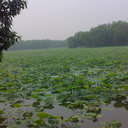[Composition characteristics of atmospheric volatile organic compounds in the urban area of Beibei District, Chongqing].
Ключови думи
Резюме
In order to study the composition and distribution of VOCs (Volatile Organic Compounds) in the atmosphere in the urban area of Beibei district, Chongqing, atmospheric samples were collected from March 2012 to February 2013 with special stainless steel cylinders, and analyzed with a three-stage preconcentration method coupled with GC-MS. 78 species of VOCs were detected in this study, of which there were 25 species of alkanes, 15 species of olefins, 28 species of aromatic hydrocarbons and 10 species of halogenated hydrocarbons. The results showed that the top seven species of VOCs according to the order of annual average concentration in the atmosphere of Beibei were: Dichloromethane (3. 08 x 10(-9) ) , Benzene (2. 09 x 10-9) , Isopentane (1. 85 x 10 -9) , Toluene (1. 51 x 10(-9)) , Propane (1. 51 x 10(-9)), m/p-xylene (1.43 x 10(-9)) and Styrene (1. 39 x 10-9). The concentration of TVOCs (Total Volatile Organic Compounds) in the atmosphere of Beibei was 33. 89 x 10 -9 during the measuring period, and the seasonal variation was obvious with the order of spring (42. 57 x 10 -9) > autumn (33.89 x 10-9) > winter (31.91 x 10 -9) > summer (27.04 x 10(-9)). In the composition of TVOCs, alkanes and aromatic hydrocarbons provided the largest contribution to TVOCs (31.5% and 30.7% ) , followed by halogenated hydrocarbon, accounting for 27.4% , and the last one was olefins, with only 10.4%. By means of ozone formation potential, the analysis results showed that olefins and aromatic hydrocarbon compounds were the two important materials which made the biggest contribution to the formation of ozone in the atmosphere of Beibei. We further analyzed the sources of VOCs in atmosphere of Beibei by the method of Principal Component Analysis (PCA). Vehicle exhaust was the biggest source and its contribution to VOCs was 50. 41%. The calculated results with T/B value also confirmed that traffic was the biggest source contributing to the VOCs in atmosphere of Beibei.





